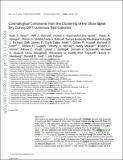Cosmological constraints from the clustering of the Sloan Digital Sky Survey DR7 luminous red galaxies
Author(s)
Reid, Beth A.; Percival, Will J.; Verde, Licia; Spergel, David N.; Skibba, Raman A.; Bahcall, Neta A.; Budavari, Tamas; Frieman, Joshua A.; Fukugita, Masataka; Gott, J. Richard; Gunn, James E.; Zeljko, Ivezic; Knapp, Gillian R.; Kron, Richard G.; Lupton, Robert H.; McKay, Timothy A.; Meiksin, Avery; Nichol, Robert C.; Pope, Adrian C.; Schlegel, David J.; Schneider, Donald P.; Stoughton, Chris; Strauss, Michael A.; Szalay, Alexander S.; Eisenstein, Daniel J.; Tegmark, Max Erik; Vogeley, Michael S.; Weinberg, David H.; York, Donald G.; Zehavi, Idit; ... Show more Show less
Downloadtegmark4.pdf (868.6Kb)
OPEN_ACCESS_POLICY
Open Access Policy
Creative Commons Attribution-Noncommercial-Share Alike
Terms of use
Metadata
Show full item recordAbstract
We present the power spectrum of the reconstructed halo density field derived from a sample of luminous red galaxies (LRGs) from the Sloan Digital Sky Survey (SDSS) Seventh Data Release (DR7). The halo power spectrum has a direct connection to the underlying dark matter power for k[greater than or equal to] 0.2 h Mpc[superscript −1], well into the quasi-linear regime. This enables us to use a factor of ∼8 more modes in the cosmological analysis than an analysis with k[subscript max]= 0.1 h Mpc[superscript −1], as was adopted in the SDSS team analysis of the DR4 LRG sample. The observed halo power spectrum for 0.02 < k < 0.2 h Mpc−1 is well fitted by our model: χ[superscript 2]= 39.6 for 40 degrees of freedom for the best-fitting Λ cold dark matter (ΛCDM) model. We find Omega[subscript m]h2(n[subscript s]/0.96)[superscript 1.2]= 0.141+[superscript 0.010][subscript −0.012] for a power-law primordial power spectrum with spectral index n[subscript s] and Omega[subscript b]h[superscript 2]= 0.022 65 fixed, consistent with cosmic microwave background measurements. The halo power spectrum also constrains the ratio of the comoving sound horizon at the baryon-drag epoch to an effective distance to z= 0.35: r[subscript s]/D[subscript V](0.35) = 0.1097[superscript +0.0039][subscript −0.0042]. Combining the halo power spectrum measurement with the Wilkinson Microwave Anisotropy Probe (WMAP) 5 year results, for the flat ΛCDM model we find Omega[subscript m]= 0.289 ± 0.019 and H[subscript 0]= 69.4 ± 1.6 km s−1 Mpc−1. Allowing for massive neutrinos in ΛCDM, we find ∑m[subscript v] <0.62 eV at the 95 per cent confidence level. If we instead consider the effective number of relativistic species N[subscript eff] as a free parameter, we find N[subscript eff]= 4.8[superscript +1.8][subscript −1.7]. Combining also with the Kowalski et al. supernova sample, we find Omega[subscript tot]= 1.011 ± 0.009 and w=−0.99 ± 0.11 for an open cosmology with constant dark energy equation of state w. The power spectrum and a module to calculate the likelihoods are publicly available at http://lambda.gsfc.nasa.gov/toolbox/lrgdr/.
Date issued
2010-03Department
Massachusetts Institute of Technology. Department of PhysicsJournal
Monthly Notices of the Royal Astronomical Society
Publisher
Wiley-Blackwell Pubishers
Citation
Reid, Beth A. et al. “Cosmological Constraints from the Clustering of the Sloan Digital Sky Survey DR7 Luminous Red Galaxies.” Monthly Notices of the Royal Astronomical Society 404.1 (May 2010): p.60-85.
Version: Author's final manuscript
ISSN
0035-8711
1365-8711